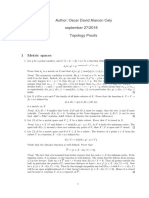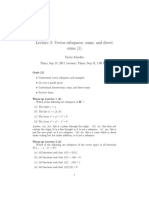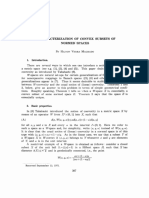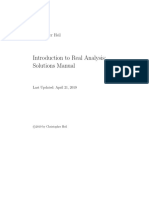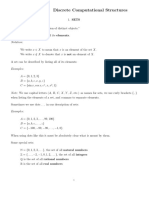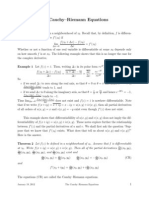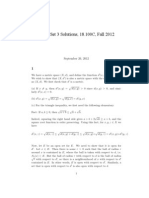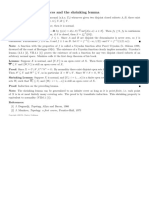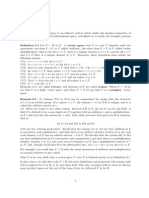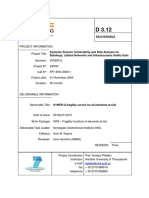4 Sums, Intersections and Direct Sums of Subspaces: 4.1 A Dimension Formula
4 Sums, Intersections and Direct Sums of Subspaces: 4.1 A Dimension Formula
Uploaded by
aba3abaCopyright:
Available Formats
4 Sums, Intersections and Direct Sums of Subspaces: 4.1 A Dimension Formula
4 Sums, Intersections and Direct Sums of Subspaces: 4.1 A Dimension Formula
Uploaded by
aba3abaOriginal Description:
Original Title
Copyright
Available Formats
Share this document
Did you find this document useful?
Is this content inappropriate?
Copyright:
Available Formats
4 Sums, Intersections and Direct Sums of Subspaces: 4.1 A Dimension Formula
4 Sums, Intersections and Direct Sums of Subspaces: 4.1 A Dimension Formula
Uploaded by
aba3abaCopyright:
Available Formats
4 Sums, intersections and direct sums of subspaces
As before let V be a vector space over the eld R (but R can be replaced with any eld F
throughout this chapter).
Lemma 4.1 Suppose that U and W are subspaces of V ; then U W is also a subspace of V .
Proof to be completed.
Remark 4.2 The union of two vector spaces is usually not a vector space. For example, let
V = R
2
and take W
1
= {(x, 0) : x R} and W
2
= {(0, y) : y R}. Then W
1
W
2
is the
set of points on the two axes. This is not closed under addition and hence is not a subspace,
since for example (1, 0) + (0, 1) is not in W
1
W
2
.
Recall that if X and Y are subspaces of V , then their sum is
X +Y = {x +y : x X, y Y }.
Lemma 4.3 Assume that X, Y are subspaces of V . Then X +Y is also a subspace of V ; it
is the smallest subspace of V which contains both X and Y .
Proof to be completed.
4.1 A dimension formula
Theorem 4.4 Suppose X, Y are subspaces of a nite-dimensional vector space V over a eld
F. Then
dim(X +Y ) = dimX + dimY dim(X Y ).
Proof Suppose D = {d
1
, . . . , d
p
} is a basis for X Y . By Theorem 3.24 D can be extended
to a basis of X, say D {x
1
, . . . , x
m
}.
Similarly, we can extend D to a basis for Y , say D {y
1
, . . . , y
r
}. We claim that
B = D {x
1
, . . . , x
m
, y
1
, . . . , y
r
}
is a basis for X +Y .
(i) To prove that B spans X +Y : Take v = x +y X +Y , then x =
i
d
i
+
j
x
j
and
y =
i
d
i
+
k
y
k
. So v =
(
i
+
i
)d
i
+
j
x
j
+
k
y
k
hence is in the span of B.
Conversely, B is a subset of X +Y and therefore the span of B is contained in X +Y .
(ii) To prove that B is linearly independent:
Suppose 0 =
i
d
i
+
j
j
x
j
+
k
y
k
with scalars
i
,
j
,
k
. Then
() z =
i
d
i
+
j
x
j
=
k
y
k
X Y.
1
Therefore z =
1
d
1
+ . . . +
p
d
p
for some
1
, . . . ,
p
R, since D is a basis for X Y . But
then we have two expressions of z as linear combinations of our basis of X, namely the rst
half of (*) and also
z =
1
d
1
+. . . +
p
d
p
+ 0.x
1
+. . . + 0.x
m
By uniqueness,
j
= 0 for all j. Similarly interchanging the roles of X and Y we get
k
= 0
for all k. Then the original linear combination becomes 0 =
i
d
i
and since D is linearly
independent, it follows that
i
= 0 for all i.
Example 4.5 Suppose dimV = 10 and X, Y are subspaces of V of dimension 6. Then
dim(XY ) 2. To prove this, note that X+Y V , and therefore dim(X+Y ) 10. From
the dimension formula,
10 6 + 6 dim(X Y )
and so dim(X Y ) 2.
The proof of Theorem 4.4 can be used to nd a basis for X +Y as in the next example.
Example 4.6 Let V = R
4
, and let
X = {(x
1
, x
2
, x
3
, x
4
) V : x
2
+x
3
+x
4
= 0},
Y = {(x
1
, x
2
, x
3
, x
4
) V : x
1
+x
2
= 0, x
3
= 2x
4
}.
We want to nd bases and dimensions for X, Y and for X Y and X + Y . Always start
by choosing a basis for the smallest subspace, here X Y , and extending to bases of larger
subspaces.
(1) We nd a basis for X Y . For this, we must solve the equations
x
2
+x
3
+x
4
= 0
x
1
+x
2
= 0
x
3
2x
4
= 0
We write down a corresponding matrix (taking the second equation rst) and nd the reduced
row echelon form
1 1 0 0
0 1 1 1
0 0 1 2
E =
1 0 0 3
0 1 0 3
0 0 1 2
.
Then X Y is the space of solutions of Ex = 0. Set x
4
= , then
X Y = {(3, 3, 2, ) : R}
with basis D = {w} where w = (3, 3, 2, 1). So X Y has dimension 1.
(2) We extend D to a basis for X.
Write X = {(x
1
, x
2
, x
3
, x
2
x
3
) : x
1
, x
2
, x
3
R} and
() (x
1
, x
2
, x
3
, x
2
x
3
) = x
1
(1, 0, 0, 0) +x
2
(0, 1, 0, 1) +x
3
(0, 0, 1, 1).
So X has a basis S = {v
1
, v
2
, v
3
} where
v
1
= (1, 0, 0, 0), v
2
= (0, 1, 0, 1), v
3
= (0, 0, 1, 1)
2
and dimX = 3. We want to apply the Steinitz Exchange Lemma to get a basis for X
containing w. We have
w = (3, 3, 2, 1) = 3v
1
+ (3)v
2
+ 2v
3
By the Steinitz Exchange Lemma Sp(S) = Sp{w, v
1
, v
3
}. This new spanning set for X has
size 3, so it must be a basis for X by Corollary 3.26. So
D {(1, 0, 0, 0), (0, 0, 1, 1)}
is a basis for X containing the basis D for X Y .
(3) Just as in (2) we can extend D to a basis for Y , for example
D {(1, 1, 0, 0)}.
(4) The proof of the dimension formula shows that then the set
D {(1, 0, 0, 0), (0, 0, 1, 1), (1, 1, 0, 0)} = {(3, 3, 2, 1), (1, 0, 0, 0), (0, 0, 1, 1), (1, 1, 0, 0)}
is a basis for X +Y .
The case when the intersection of the two subspaces X and Y is zero is important.
Denition 4.7 The vector space V is the direct sum of subspaces X and Y if
(i) X Y = {0}, and
(ii) X +Y = V .
If so, we write V = X Y .
Lemma 4.8 Suppose X and Y are subspaces of V . Then V = X Y if and only if every
v V has a unique expression v = x +y with x X and y Y .
Proof to be completed.
Lemma 4.9 Suppose X and Y are subspaces of V . Then the following are equivalent:
(a) V = X Y
(b) X Y = {0} and dimV = dimX + dimY
(c) X +Y = V and dimV = dimX + dimY .
Proof to be completed.
Corollary 4.10 Assume that V = X Y is the direct sum of subspaces X and Y . Suppose
that B is a basis for X and C is a basis for Y . Then the union B C is a basis for V .
Proof: This is a special case of the proof of Theorem 4.4.
3
You might also like
- Jim Rohn - 12 PillarsDocument17 pagesJim Rohn - 12 PillarsMarco199897% (39)
- Solutions To Axler Linear Algebra Done RightDocument35 pagesSolutions To Axler Linear Algebra Done RightJitender Singh71% (7)
- Business Plan Grade 11 AbmDocument16 pagesBusiness Plan Grade 11 AbmErwin Ablao100% (6)
- Kayode Oladipupo Olayemi: Research Proposal OnDocument9 pagesKayode Oladipupo Olayemi: Research Proposal OnKAYODE OLADIPUPONo ratings yet
- The Global Case For Strategic Asset Allocation and An Examination of Home Bias - Thierry PollaDocument20 pagesThe Global Case For Strategic Asset Allocation and An Examination of Home Bias - Thierry PollaThierry PollaNo ratings yet
- LinalgDocument13 pagesLinalgsumanroyalNo ratings yet
- Linear Spaces Teaching Slides HandoutDocument109 pagesLinear Spaces Teaching Slides HandoutJayakanth Abhimanyu MallelaNo ratings yet
- HW 3 SolDocument5 pagesHW 3 SolJuan David TorresNo ratings yet
- Topology I - Exercises and Solutions: Author: Oscar David Alarcon CelyDocument10 pagesTopology I - Exercises and Solutions: Author: Oscar David Alarcon CelyOscar Alarcon CelyNo ratings yet
- 1 Complete Metric SpacesDocument5 pages1 Complete Metric SpacesKuldeepNo ratings yet
- Mid-Term Exam: Geometry/Topology IDocument3 pagesMid-Term Exam: Geometry/Topology IJuwandaNo ratings yet
- MocksolutionDocument8 pagesMocksolutionoussama sadkiNo ratings yet
- 5 1Document2 pages5 1Ayush ShivhareNo ratings yet
- Topology Notes 00Document11 pagesTopology Notes 00James MlotshwaNo ratings yet
- 190 W 16 HW8 SolnDocument3 pages190 W 16 HW8 Solnalfonso_bajarNo ratings yet
- AssignmentDocument6 pagesAssignmentBALARAM SAHUNo ratings yet
- Suzuki Dan Takahashi, 2016 (Ada Penjelasan Dari Park Dan Kang, 1993)Document12 pagesSuzuki Dan Takahashi, 2016 (Ada Penjelasan Dari Park Dan Kang, 1993)ajiiib 27No ratings yet
- Fundamentals of Vector Spaces and Subspaces: Kevin JamesDocument17 pagesFundamentals of Vector Spaces and Subspaces: Kevin JamesGustavo G Borzellino CNo ratings yet
- Differential Geometr1Document17 pagesDifferential Geometr1hayatianjourneyNo ratings yet
- Homework 4Document4 pagesHomework 4Luis EduardoNo ratings yet
- Course 4: 22.10.2020 2.3 Generated Subspace: I I I I I IDocument5 pagesCourse 4: 22.10.2020 2.3 Generated Subspace: I I I I I IPop RobertNo ratings yet
- Discrete Computational Structures NotesDocument6 pagesDiscrete Computational Structures Notes2430972No ratings yet
- Vector Spaces: 3.1 Abstract DefinitionDocument14 pagesVector Spaces: 3.1 Abstract DefinitionDT Goutam BeheraNo ratings yet
- Linear Algebra Cambridge Mathematical Tripos Part IBDocument58 pagesLinear Algebra Cambridge Mathematical Tripos Part IBharryNo ratings yet
- Hartshorne Algebraic Geometry SolutionsDocument130 pagesHartshorne Algebraic Geometry SolutionsFrank WanNo ratings yet
- MATH 423 Linear Algebra II Advanced Constructions of Vector SpacesDocument9 pagesMATH 423 Linear Algebra II Advanced Constructions of Vector SpacesYanh VissuetNo ratings yet
- A Characterization of Convex Subsets of Normed Spaces: Kodai Math. Sem. Rep 25 (1973) - 307-320Document14 pagesA Characterization of Convex Subsets of Normed Spaces: Kodai Math. Sem. Rep 25 (1973) - 307-320victorjuma745No ratings yet
- 00 Metric SpacesDocument4 pages00 Metric Spacesapi-3808925No ratings yet
- Introduction To Real Analysis Instructor Solution Manual 1nbsped 3030269019 9783030269012 - CompressDocument429 pagesIntroduction To Real Analysis Instructor Solution Manual 1nbsped 3030269019 9783030269012 - Compressyousafzaimudassir905No ratings yet
- Compact 1Document9 pagesCompact 1AHALYA ANINo ratings yet
- Functional Analysis: Problem Sheet 3: Paul D. MitchenerDocument2 pagesFunctional Analysis: Problem Sheet 3: Paul D. MitchenerZohaib ShabirNo ratings yet
- Linear Algebra Done Right - SolutionsDocument9 pagesLinear Algebra Done Right - SolutionsfunkageNo ratings yet
- 7 The Fundamentals of Topology: 7.1 Open and Closed SetsDocument5 pages7 The Fundamentals of Topology: 7.1 Open and Closed Setsayaan malikNo ratings yet
- Expanded Version of Zagier's Proof of Fermat's Two Square TheoremDocument5 pagesExpanded Version of Zagier's Proof of Fermat's Two Square TheorembaynhamianNo ratings yet
- Metric Spaces: 1.1 Definition and ExamplesDocument103 pagesMetric Spaces: 1.1 Definition and ExamplesNguyễn Quang HuyNo ratings yet
- COMS 1016: Discrete Computational StructuresDocument6 pagesCOMS 1016: Discrete Computational StructuresThabo MathebulaNo ratings yet
- 1 Baire's Theorem and Its ApplicationsDocument5 pages1 Baire's Theorem and Its ApplicationsJosephPmNo ratings yet
- Solutions 4 - 640Document3 pagesSolutions 4 - 640Calixto RhenalsNo ratings yet
- Top Fan03Document4 pagesTop Fan03suryawanshiatharva2029No ratings yet
- 110 M1 ReviewDocument6 pages110 M1 ReviewdepthofmlNo ratings yet
- Hartshorne Algebraic Geometry SolutionsDocument130 pagesHartshorne Algebraic Geometry SolutionsΠΤΟΛΕΜΑΙΟΣ ΗΡΑΚΛΕΙΔΗΣ50% (2)
- Solutions 3 - 640Document3 pagesSolutions 3 - 640Calixto RhenalsNo ratings yet
- Cauchy Riemann EquationDocument6 pagesCauchy Riemann EquationeSinist3rNo ratings yet
- Metric Space: X X y yDocument20 pagesMetric Space: X X y yWazha MmerekiNo ratings yet
- LALect01Document14 pagesLALect01gogombodj22No ratings yet
- MIT18 100CF12 Prob Set 3Document5 pagesMIT18 100CF12 Prob Set 3Daniel Lee Eisenberg JacobsNo ratings yet
- 01 Top PDFDocument8 pages01 Top PDFAsifNo ratings yet
- Normality of Metric Spaces and The Shrinking Lemma: S S S S S 1 S A A B 1 1Document1 pageNormality of Metric Spaces and The Shrinking Lemma: S S S S S 1 S A A B 1 1Avijit SamantaNo ratings yet
- Homework 1 - SolutionsDocument3 pagesHomework 1 - Solutionsneelann8902No ratings yet
- hw4 Math3410 S23solutionsDocument4 pageshw4 Math3410 S23solutionstaxin90604No ratings yet
- Midterm 2021 Topology SolutionsDocument3 pagesMidterm 2021 Topology SolutionsninimanagadzeNo ratings yet
- Chapter 11 SolutionsDocument3 pagesChapter 11 SolutionsAli INo ratings yet
- Finalreview Nosolutions PDFDocument5 pagesFinalreview Nosolutions PDFWilliam PruittNo ratings yet
- Embeddings ExtensionsDocument65 pagesEmbeddings Extensionssab238633No ratings yet
- Section14 4Document26 pagesSection14 4tam.le2302220No ratings yet
- Elgenfunction Expansions Associated with Second Order Differential EquationsFrom EverandElgenfunction Expansions Associated with Second Order Differential EquationsNo ratings yet
- Vdocument - in - London Stock Exchange Group 2020 02 25 Connectivity CMC Exchange HostingDocument38 pagesVdocument - in - London Stock Exchange Group 2020 02 25 Connectivity CMC Exchange Hostingaba3abaNo ratings yet
- MiFID Refit - Euronext High Level Positions On Equities Market Structure FINALDocument2 pagesMiFID Refit - Euronext High Level Positions On Equities Market Structure FINALaba3abaNo ratings yet
- Vishal Arora (DA)Document1 pageVishal Arora (DA)aba3abaNo ratings yet
- Rfs Eng 1Document14 pagesRfs Eng 1aba3abaNo ratings yet
- Coaching The Inner-Game of Trading: Monika MüllerDocument7 pagesCoaching The Inner-Game of Trading: Monika Mülleraba3abaNo ratings yet
- Brokers On The Run: InsightsDocument3 pagesBrokers On The Run: Insightsaba3abaNo ratings yet
- Saisonalitaet eDocument5 pagesSaisonalitaet ephilippepssb2No ratings yet
- Technical Analysis For Beginners: by Emilio TomasiniDocument16 pagesTechnical Analysis For Beginners: by Emilio Tomasiniaba3abaNo ratings yet
- 2005trading Parabolic TrendsDocument4 pages2005trading Parabolic Trendsaba3abaNo ratings yet
- All CQGIC UGs PDFDocument1,840 pagesAll CQGIC UGs PDFaba3abaNo ratings yet
- Spotlight: Key Themes For UK Real Estate in 2014Document6 pagesSpotlight: Key Themes For UK Real Estate in 2014aba3abaNo ratings yet
- CQG API BrochureDocument4 pagesCQG API Brochureaba3abaNo ratings yet
- London Infrastructure Spotlight London InfrastructureDocument8 pagesLondon Infrastructure Spotlight London Infrastructureaba3abaNo ratings yet
- Simplicity Is BestDocument7 pagesSimplicity Is Bestaba3aba100% (1)
- Commercial Research Central London OfficesDocument8 pagesCommercial Research Central London Officesaba3abaNo ratings yet
- 2 Vector Spaces: V V V VDocument7 pages2 Vector Spaces: V V V Vaba3abaNo ratings yet
- Prelims Linear Algebra I: 1.1 Addition and Scalar Multiplication of MatricesDocument11 pagesPrelims Linear Algebra I: 1.1 Addition and Scalar Multiplication of Matricesaba3abaNo ratings yet
- HFF Hedge FundsDocument34 pagesHFF Hedge Fundsaba3abaNo ratings yet
- LA Sheet2 12Document1 pageLA Sheet2 12aba3abaNo ratings yet
- A Rapid Colorimetric Detection of Melamine in Raw Milk by Unmodified Gold NanoparticlesDocument8 pagesA Rapid Colorimetric Detection of Melamine in Raw Milk by Unmodified Gold NanoparticlesSlimani DalelNo ratings yet
- Asthma Training Module 2013Document204 pagesAsthma Training Module 2013Carlo AlvaradoNo ratings yet
- FMG90 Series: With PVDF and 316L ConstructionDocument2 pagesFMG90 Series: With PVDF and 316L ConstructionRavi RanjanNo ratings yet
- Sangre Azteca Gary Jennings Descargar GratisDocument3 pagesSangre Azteca Gary Jennings Descargar GratisTri LineNo ratings yet
- Eapp Final ReportDocument18 pagesEapp Final Reportjohanna patayecNo ratings yet
- SolutionDocument7 pagesSolutionNishant kumarNo ratings yet
- Terna Engineering College: LAB Manual Part ADocument7 pagesTerna Engineering College: LAB Manual Part APrathmesh GaikwadNo ratings yet
- A Tale of Two Cities - The Aftermath of Partition For Lahore and Amritsar 1947-1957Document36 pagesA Tale of Two Cities - The Aftermath of Partition For Lahore and Amritsar 1947-1957ParulNo ratings yet
- Polietileno LDF 1925 - HMDocument1 pagePolietileno LDF 1925 - HMMariangela Nava0% (1)
- View Selection Guide PDFDocument56 pagesView Selection Guide PDFJorge AlvearNo ratings yet
- LESSON PLAN 3.2 Living and Non-LivingDocument8 pagesLESSON PLAN 3.2 Living and Non-LivingAnonymous ZAqf8ONo ratings yet
- Imaginary and Complex NumbersDocument28 pagesImaginary and Complex NumbersZenonissya Galwan BataraNo ratings yet
- Evolution Healing Centre - Lived Experiences of Stroke For Bermuda 2022Document22 pagesEvolution Healing Centre - Lived Experiences of Stroke For Bermuda 2022BernewsAdminNo ratings yet
- MANAGEMENT - MANAGEMENT PRINCIPLES AND APPLICATION 3rd SemDocument2 pagesMANAGEMENT - MANAGEMENT PRINCIPLES AND APPLICATION 3rd SemUzair ShahNo ratings yet
- Multi-Purpose Plants For API Production: Facilities and EquipmentDocument5 pagesMulti-Purpose Plants For API Production: Facilities and EquipmentYanti SusilawatiNo ratings yet
- SOAL CASE 14 - 33 Dan CASE 16-35Document4 pagesSOAL CASE 14 - 33 Dan CASE 16-35Rictu SempakNo ratings yet
- ReadmeDocument20 pagesReadmemiskoajkulaNo ratings yet
- Logical Reasoning TestsDocument7 pagesLogical Reasoning Testsls-checkinNo ratings yet
- Skookum Minutes 2018-08-08 DraftDocument1 pageSkookum Minutes 2018-08-08 DraftSteveNo ratings yet
- Shobhit Nirwan Chemistry Class 11Document246 pagesShobhit Nirwan Chemistry Class 11KiraNo ratings yet
- D3.12 - SYNER-G Fragility Curves For All Elements at RiskDocument145 pagesD3.12 - SYNER-G Fragility Curves For All Elements at RiskMohammad AL HaririNo ratings yet
- Advantages and Disadvantages of Technology in Our Life: Presented:By Group2Document13 pagesAdvantages and Disadvantages of Technology in Our Life: Presented:By Group2Daryn CorpusNo ratings yet
- Speech: Types of SpeechesDocument5 pagesSpeech: Types of SpeechesJane Sagutaon100% (1)
- Path TraversalDocument8 pagesPath TraversallimingNo ratings yet
- Consumer SatisfactionDocument21 pagesConsumer SatisfactiongoswamiphotostatNo ratings yet
- The 100 Most Cited Articles in Prosthodontic Journals: A Bibliometric Analysis of Articles Published Between 1951 and 2019Document7 pagesThe 100 Most Cited Articles in Prosthodontic Journals: A Bibliometric Analysis of Articles Published Between 1951 and 2019Najeeb UllahNo ratings yet








